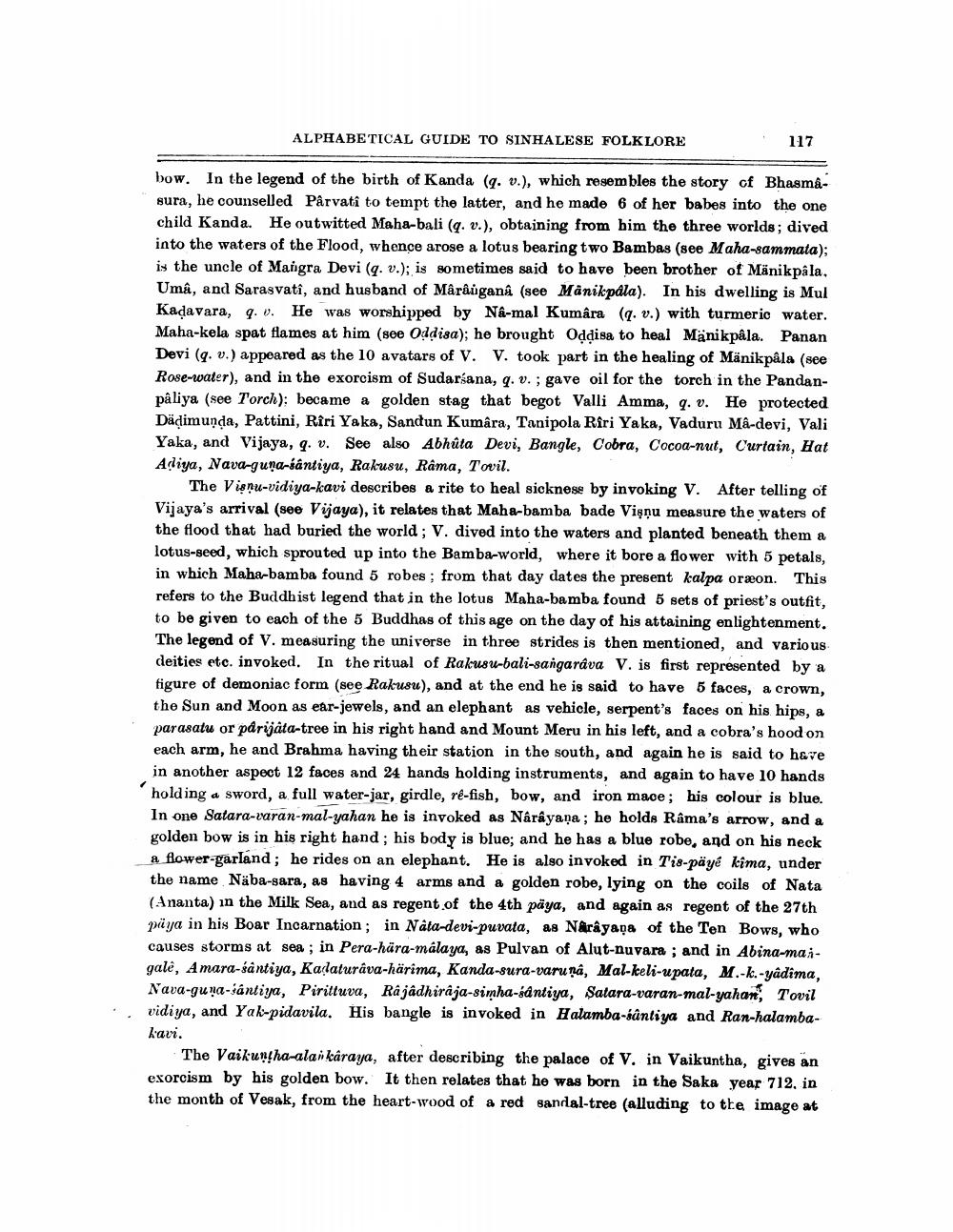________________
ALPHABETICAL GUIDE TO SINHALESE FOLKLORE
117
bow. In the legend of the birth of Kanda (q. v.), which resembles the story of Bhasmâsura, he counselled Pârvati to tempt the latter, and he made 6 of her babes into the one child Kanda. He outwitted Maha-bali (q. v.), obtaining from him the three worlds; dived into the waters of the Flood, whence arose a lotus bearing two Bambas (see Maha-sammata); is the uncle of Mangra Devi (q. v.); is sometimes said to have been brother of Mänikpâla. Umâ, and Sarasvatî, and husband of Mârâiganâ (see Manikpala). In his dwelling is Mul Kadavara, q. v. He was worshipped by Na-mal Kumâra (q. v.) with turmeric water. Maha-kela spat flames at him (see Oddisa); he brought Oddisa to heal Manikpâla. Panan Devi (q. v.) appeared as the 10 avatars of V. V. took part in the healing of Mänikpâla (see Rose-water), and in the exorcism of Sudarsana, q. v. ; gave oil for the torch in the Pandanpâliya (see Torch): became a golden stag that begot Valli Amma, q. v. He protected Däḍimunda, Pattini, Rîri Yaka, Sandun Kumâra, Tanipola Rîri Yaka, Vaduru Mâ-devi, Vali Yaka, and Vijaya, q. v. See also Abhûta Devi, Bangle, Cobra, Cocoa-nut, Curtain, Hat Adiya, Nava-guna-santiya, Rakusu, Râma, Tovil.
The Visnu-vidiya-kavi describes a rite to heal sickness by invoking V. After telling of Vijaya's arrival (see Vijaya), it relates that Maha-bamba bade Visņu measure the waters of the flood that had buried the world; V. dived into the waters and planted beneath them a lotus-seed, which sprouted up into the Bamba-world, where it bore a flower with 5 petals, in which Maha-bamba found 5 robes; from that day dates the present kalpa oræon. This refers to the Buddhist legend that in the lotus Maha-bamba found 5 sets of priest's outfit, to be given to each of the 5 Buddhas of this age on the day of his attaining enlightenment. The legend of V. measuring the universe in three strides is then mentioned, and various deities etc. invoked. In the ritual of Rakusu-bali-sangarâva V. is first represented by a figure of demoniac form (see Rakusu), and at the end he is said to have 5 faces, a crown, the Sun and Moon as ear-jewels, and an elephant as vehicle, serpent's faces on his hips, a parasatu or pârijata-tree in his right hand and Mount Meru in his left, and a cobra's hood on each arm, he and Brahma having their station in the south, and again he is said to have in another aspect 12 faces and 24 hands holding instruments, and again to have 10 hands holding a sword, a full water-jar, girdle, rê-fish, bow, and iron mace; his colour is blue. In one Satara-varan-mal-yahan he is invoked as Nârâyana; he holds Râma's arrow, and a golden bow is in his right hand; his body is blue; and he has a blue robe, and on his neck a flower-garland; he rides on an elephant. He is also invoked in Tis-päyé kima, under the name Näba-sara, as having 4 arms and a golden robe, lying on the coils of Nata (Ananta) in the Milk Sea, and as regent of the 4th paya, and again as regent of the 27th paya in his Boar Incarnation; in Nata-devi-puvata, as Narayana of the Ten Bows, who causes storms at sea; in Pera-hära-malaya, as Pulvan of Alut-nuvara; and in Abina-maigalê, Amara-santiya, Kaḍaturâva-härima, Kanda-sura-varunâ, Mal-keli-upata, M.-k.-yadima, Nava-guna-santiya, Piriltuva, Rajâdhirâja-simha-śântiya, Satara-varan-mal-yahan, Tovil vidiya, and Yak-pidavila. His bangle is invoked in Halamba-sântiya and Ran-halambakavi.
The Vaikuntha-alankaraya, after describing the palace of V. in Vaikuntha, gives an exorcism by his golden bow. It then relates that he was born in the Saka year 712, in the month of Vesak, from the heart-wood of a red sandal-tree (alluding to the image at




